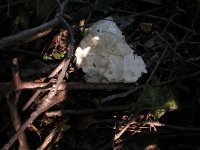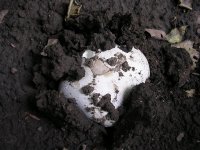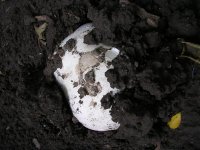Larry Lade
Moderator
OK all you mycologists out there. I have never seen a mushroom quite like this one!
I found this white thing out in our backyard a couple of days ago. I first I though it was a piece of styrofoam, which had been "nicked up" a bit. But this morning I found this other "white form" breaking through the ground (it had one "nick" in it). I am uncertain just what would be feeding on these fungi. I would suppose that possibly the numerour Fox Squirrels which we have in our yard might find them to their liking.
These two fungi are approximately one foot in diameter (the actual diameter of the one in photos 3 and 4 is not entirely above ground yet).
Attached are a few photos which I shot this morning.
Photo # 1 is of the "nicked up" fungus.
Photo # 4 and photo # 5 are of the fungus beginning to surface, and only has the one "nick" in it
I found this white thing out in our backyard a couple of days ago. I first I though it was a piece of styrofoam, which had been "nicked up" a bit. But this morning I found this other "white form" breaking through the ground (it had one "nick" in it). I am uncertain just what would be feeding on these fungi. I would suppose that possibly the numerour Fox Squirrels which we have in our yard might find them to their liking.
These two fungi are approximately one foot in diameter (the actual diameter of the one in photos 3 and 4 is not entirely above ground yet).
Attached are a few photos which I shot this morning.
Photo # 1 is of the "nicked up" fungus.
Photo # 4 and photo # 5 are of the fungus beginning to surface, and only has the one "nick" in it






